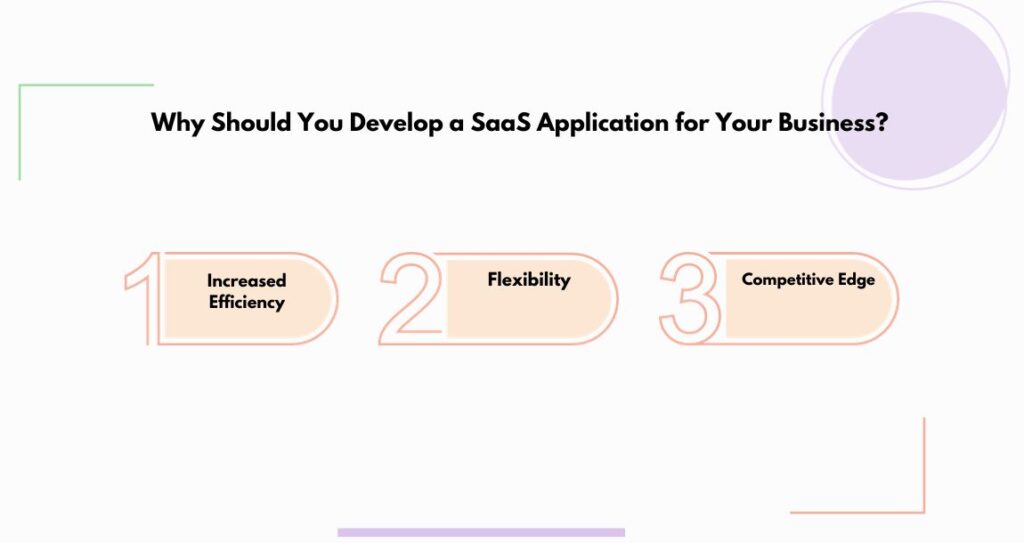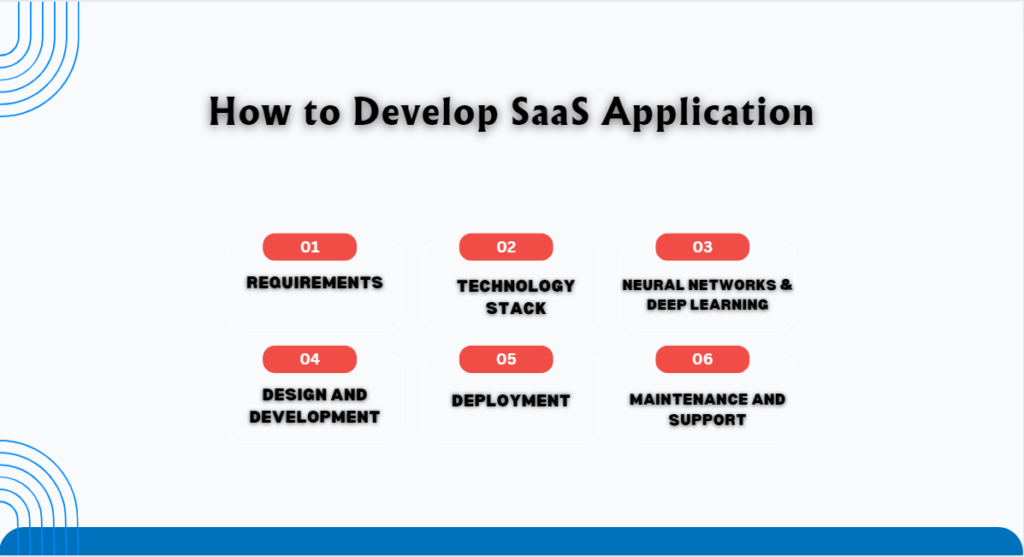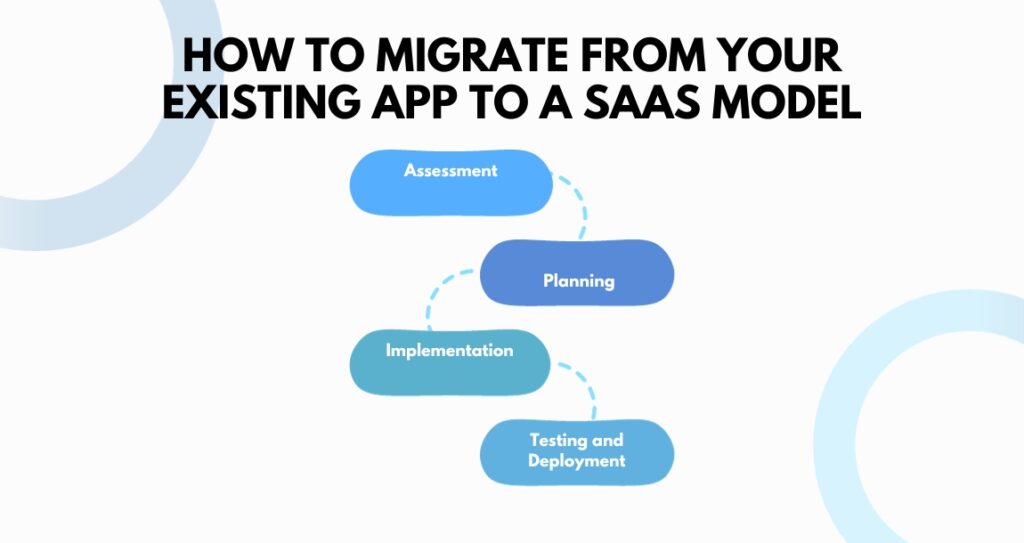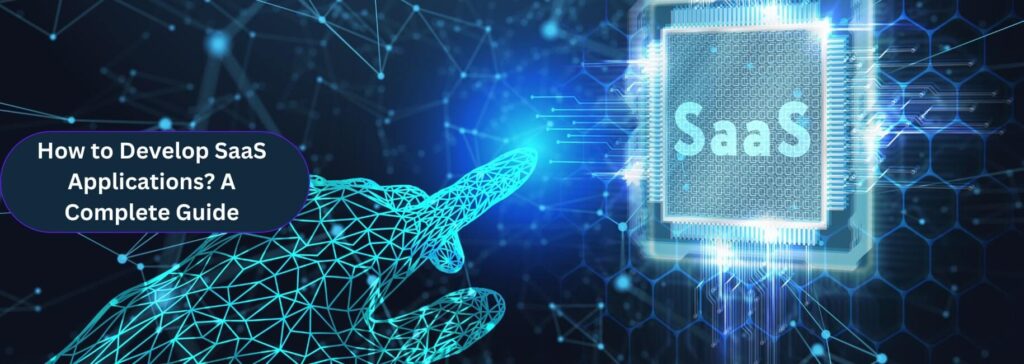In the ever-evolving landscape of technology, the question of how to develop SaaS applications has become increasingly relevant and vital.
As businesses across the globe strive to enhance efficiency, reduce costs, and provide seamless experiences to their customers, Software as a Service (SaaS) emerges as a compelling solution.
But what exactly does it mean to develop a SaaS application, and why is it becoming a preferred choice for many organizations?
SaaS applications are cloud-based software solutions hosted on a central server and accessed through a web browser.
Unlike traditional Software that requires installation on individual devices, SaaS offers unparalleled accessibility and flexibility.
Whether a small startup or a large enterprise, understanding how to develop SaaS applications can transform how you operate and compete in the market.
Contents
What is a SaaS Application?
In the bustling world of technology, SaaS stands out as a game-changer. Short for Software as a Service, SaaS revolutionizes the way we interact with Software.
Gone are the days of cumbersome installations and device-specific access. With SaaS, the Software lives on a central server. Imagine having a powerful and robust tool at your fingertips, no matter where you are.
That’s the magic of SaaS. You’re at the office, home, or even on vacation, and your Software is right there; no need to worry about compatibility or updates. The provider takes care of everything.
Key Features of SaaS Applications
Now, let’s delve into the key features that make SaaS a compelling choice.
1. Accessibility: Accessible from Anywhere & Any Device with an Internet Connection
Accessibility is the cornerstone of SaaS. Do you have a laptop, a tablet, or a smartphone? Great! SaaS is there for you. Connect to the internet, open your browser, and you’re in.
Work continues seamlessly, whether in a coffee shop or a conference room. Collaboration becomes effortless. Team members across the globe can work on the same project in real-time. Barriers crumble, and productivity soars.
2. Scalability: Easily Scalable to Accommodate Growing Business Needs
Business growth is exciting but can be challenging. With traditional Software, growth means more licenses, hardware, and headaches. SaaS changes the equation.
Is your business expanding? SaaS grows with you. Add users, increase capacity, or even add new features. It happens smoothly without the need to overhaul your entire system.
Flexibility becomes the norm, not the exception. You focus on growing your business, and SaaS takes care of the rest.
3. Cost-Effective: Reduces the Need for Physical Infrastructure and Maintenance
Costs can be a barrier to innovation. Traditional Software requires significant investment in infrastructure and maintenance. SaaS turns that model on its head.
The provider hosts the Software, ensures it’s up to date, and takes care of any issues. You pay for what you use, often through a subscription model. Budgeting becomes more predictable.
Resources can be redirected to areas that drive your business forward. Efficiency isn’t just a buzzword; it’s a tangible benefit that impacts your bottom line.
SaaS isn’t just a trend; it’s a fundamental shift in how we use Software. Accessibility, scalability, and cost-effectiveness aren’t just features; they’re the pillars that support a new way of doing business.
SaaS offers a path to innovation, collaboration, and growth from small startups to global corporations. Embrace the future, and see where SaaS can take you.
Why Should You Develop a SaaS Application for Your Business?

In the modern business landscape, staying ahead of the curve is paramount. Competition is fierce. Efficiency, flexibility, and innovation are not just buzzwords but essential to success.
Enter SaaS or Software as a Service. A solution that’s not just a trend but a transformative force. Let’s explore why developing a SaaS application for your business might be the game-changer you’ve been looking for.
1. Increased Efficiency: Streamlines Processes and Improves Collaboration
Efficiency drives success. Time is money, as the saying goes. SaaS takes this to heart. Streamlining processes saves time—no more waiting for files to transfer or updates to install.
Everything is real-time. Collaboration becomes a breeze. Team members can work together, even if they’re miles apart.
Projects move faster. Deadlines are met with ease. Stress levels go down. Productivity goes up. It’s a win-win situation.
But that’s not all. SaaS applications are hosted in the cloud. Access is instant from anywhere—work from home, the office, or on the road. The location doesn’t matter. What matters is getting the job done, and SaaS makes that happen.
No more barriers. No more delays. Just smooth, efficient operation that propels your business forward.
2. Flexibility: Customizable to Fit Specific Business Needs
Every business is unique. Needs vary. Goals differ. Traditional Software can be rigid, forcing you to adapt to its limitations. SaaS changes that. It’s flexible, adaptable, and customizable.
Need a specific feature? Add it. Want to integrate with another tool? Do it. SaaS bends to fit your needs, not the other way around.
Imagine a tool that evolves with your business. As you grow, it grows. As you change, it changes. That’s the power of SaaS. It’s not a one-size-fits-all solution.
It’s a dynamic platform that molds itself to your specific needs. No more workarounds. No more compromises. It is Just a tailored solution that works for you.
3. Competitive Edge: Stay Ahead of Competitors with Innovative Solutions
Competition is relentless. Staying ahead requires innovation. SaaS fosters that innovation. It’s not just a tool; it’s a platform for growth. New ideas can be tested quickly.
Feedback is immediate. Adjustments are easy. Innovation becomes part of your culture, not just a buzzword. Your competitors are moving fast. SaaS helps you move faster. Launch new features. Explore new markets. Adapt to changes.
All of it happens at a pace that keeps you ahead. You’re not just keeping up; you’re leading the way. SaaS also levels the playing field.
Small businesses can compete with giants. Resources are optimized. Costs are controlled. Opportunities are seized. You’re not just surviving; you’re thriving.
The decision to develop a SaaS application for your business is not just strategic; it’s transformative.
Efficiency, flexibility, and competitive edge are not mere benefits but essential to modern business success. SaaS is not just a solution; it’s a pathway to growth, innovation, and leadership.
How to Develop SaaS Applications

The digital age has brought about a revolution in how we use Software. SaaS, or Software as a Service, is at the forefront of this transformation. But how does one go about developing a SaaS application?
It’s not just about writing code; it’s about crafting a solution that meets specific needs, performs flawlessly, and provides value to users. Let’s explore the journey of SaaS development, one step at a time.
1. Understanding the Requirements
Every successful project starts with understanding. Who will use the application? What do they need? What problems will it solve? These questions are vital. Research is key. Surveys, interviews, and market analysis can provide insights.
The target audience must be defined. Their needs must be understood. Goals must be set. A clear vision must be established. Without this foundation, the project can falter.
But understanding goes beyond the surface. Dive deep into the user’s world. Explore their pain points. Discover their desires. Uncover their habits.
The more you know, the better the solution will be. It’s not just about meeting needs; it’s about exceeding expectations.
2. Choosing the Correct Technology Stack
Technology is the engine that drives SaaS. But not all technology is created equal. The right tools must be chosen.
The right technologies must be selected. Consider the requirements. Evaluate the options. Consult with experts. Make informed decisions.
The technology stack is not just a collection of tools. It’s the backbone of the application. It must be robust. It must be scalable. It must be secure. Choose wisely, for the success of the project depends on it.
But choosing is not enough. Stay updated. Technology evolves. New tools emerge. Best practices change. Continuous learning is essential. Adaptation is necessary. Stay ahead of the curve, and the path to success will be smooth.
3. Design and Development
Design is not just about aesthetics. It’s about functionality. It’s about user experience. The interface must be user-friendly. Navigation must be intuitive. Features must be accessible. The user’s journey must be seamless.
Development goes hand in hand with design. The backend must be robust. The code must be clean. Architecture must be solid. Performance must be optimized. Security must be tight. Every detail matters. Every line of code counts.
Collaboration between designers and developers is crucial. Communication must be clear. Goals must be aligned. Feedback must be constructive. Teamwork makes the dream work, as they say.
4. Testing
Testing is not an afterthought. It’s an integral part of the process. Bugs must be found. Performance must be assessed. User experience must be evaluated. Testing must be thorough. It must be systematic. It must be relentless.
Automated tests save time. Manual tests provide insights. Both are essential. Test early. Test often. Test everything. Leave no stone unturned. Quality is not negotiable. Excellence is the goal.
Users can be involved too. Beta testing provides real-world feedback. Users see things differently. They find issues you might miss.
They provide insights you might overlook. Embrace their feedback. Learn from their experience. Improve and excel.
5. Deployment
Deployment is the moment of truth. Months of hard work come to fruition. The application goes live. Users begin to explore. Excitement fills the air. But deployment is not just about launching.
It’s about ensuring a smooth transition. The hosting platform must be suitable. It must be secure and scalable. Consider the traffic. Anticipate the load. Prepare for success.
Choose a hosting platform that can handle growth. Monitor the performance. Analyze the usage. Adapt as needed. Deployment is not a one-time event; it’s an ongoing process.
But don’t forget the user. Notify them of the launch. Provide guidance. Offer support. Make their first experience memorable.
Turn them into advocates. Let them spread the word. A successful launch is not just about technology; it’s about people.
6. Maintenance and Support
The journey doesn’t end with deployment. It continues with maintenance and support. Users have questions. They encounter issues. They need help. Support must be available.
It must be responsive and empathetic. Happy users are loyal users. Support them, and they will support you. Maintenance is equally vital—technology changes. Needs evolve—the market shifts.
The application must adapt. Regular updates are essential. New features may be needed. Performance may need optimization. Security must be maintained. Maintenance is not a chore; it’s an opportunity to improve, innovate, and excel.
But don’t just react; be proactive. Monitor the application. Gather feedback. Analyze the data. Anticipate the needs. Stay ahead of the curve.
Turn challenges into opportunities. Make every update an event. Keep the users engaged. Keep them excited. Keep them coming back for more.
Developing a SaaS application is a journey filled with challenges and opportunities. Understanding every step is vital—every decision matters. Every detail counts.
It’s about crafting a solution that provides value, meets needs, and exceeds expectations. SaaS is not just a trend; it’s a transformative force in the world of Software.
It’s not just a product; it’s a service that builds relationships, fosters loyalty, and drives success. Embrace the journey. Embrace the challenges. Embrace the opportunities. The path to success is not easy, but worth every step.
How to Migrate from Your Existing App to a SaaS Model

Migrating an existing application to a SaaS model is a journey. It is filled with challenges, opportunities, and rewards.
It’s not just about moving to the cloud; it’s about transforming an application into a dynamic, scalable, and valuable service.
From assessment to deployment, every step is vital—every decision matters. Every detail counts. Collaboration, creativity, commitment, and continuous improvement are the keys to success.
The world is moving to the cloud, and SaaS (Software as a Service) is leading the way. But what if you have an existing application? Can you join the SaaS revolution?
The answer is a resounding yes! Migrating an existing application to a SaaS model is not just possible; it’s a pathway to new opportunities, markets, and success. Let’s explore this journey step by step.
1. Assessment
Migration begins with assessment. Know your application inside and out. Analyze its architecture. Understand its dependencies. Identify its limitations. Every detail matters. Every component counts.
But don’t just look at the code. Consider the users. Evaluate their experience. Understand their needs. Identify areas for improvement.
Migration is more than about moving to the cloud. It’s about enhancing value, improving performance, and exceeding expectations.
Engage experts if needed. Seek external opinions. Collaborate with stakeholders. Gather insights from different perspectives.
A well-rounded assessment provides a clear picture, identifies challenges, and sets the stage for informed decisions.
2. Planning
Planning is the bridge between assessment and implementation. It’s where vision meets action. Define the migration strategy. Choose the right tools. Select the appropriate cloud platform.
Consider security, scalability, and compliance. Every decision shapes the future of the application. Set a timeline. Break down the process into manageable tasks. Assign responsibilities—set milestones.
Monitor progress. A well-defined timeline keeps the project on track, ensures accountability, and fosters collaboration. But planning is not set in stone. Be flexible. Adapt to changes. Respond to challenges.
Remember the big picture, but be ready to adjust the details. A dynamic plan is a resilient plan capable of navigating the twists and turns of the migration journey.
3. Implementation
Implementation is where ideas become a reality. Modify the application to fit the SaaS model. Re-architect if needed.
Optimize for the cloud. Enhance performance. Improve user experience. Every change is a step towards transformation.
Collaborate with the team—foster creativity. Encourage innovation. Provide support. Celebrate progress. Implementation is not just about coding but teamwork, creativity, and commitment.
Monitor the process. Track the changes. Validate the decisions. Ensure alignment with the plan. Stay focused on the goals.
Keep the vision clear. Implementation is a journey filled with challenges and opportunities. Embrace them, learn from them, and grow.
4. Testing and Deployment
Testing is the guardian of quality. It ensures that the migrated application meets expectations. Functionality must be verified.
Performance must be assessed. Security must be validated. User experience must be evaluated. Testing is not just a phase; it’s a continuous commitment to excellence.
Automated tests save time. Manual tests provide insights. Both are essential. Test in different environments. Simulate real-world scenarios. Involve users if possible. Their feedback is invaluable.
They provide a perspective that’s grounded in reality. But testing is not just about finding issues but solving them. Collaborate with the team. Share the findings. Discuss the solutions. Make informed decisions.
Testing is a collaborative effort to enhance quality, build confidence, and ensure success. Deployment is the culmination of the migration journey. It’s where the new SaaS application meets the world.
Choose the right hosting platform. Consider scalability, reliability, and cost. Plan the launch. Communicate with users. Provide support. Make the transition smooth.
Monitor the deployment. Analyze the performance. Gather feedback. Respond to issues. Deployment is not a one-time event; it’s an ongoing process. The application will evolve. The market will change. The users will grow.
Deployment sets the stage for continuous improvement, ongoing success, and future growth. Embrace the SaaS model. Embrace the cloud. Embrace the future. The path may be complex, but the destination is worth every effort.
The SaaS revolution is here, and it’s waiting for you. Join the movement, and see where it takes you.
Conclusion
Understanding how to develop SaaS applications is vital in today’s technology-driven landscape. From the initial concept to migration, this comprehensive guide has provided insights into every aspect of SaaS development.
Whether you’re a seasoned developer or a business owner looking to innovate, SaaS offers a flexible, cost-effective solution.
But embarking on the SaaS journey doesn’t have to be a solitary endeavor. Webisoft, the SaaS development service provider, specializes in guiding businesses and developers through the complexities of SaaS development and migration.
With our expertise, state-of-the-art tools, and commitment to excellence, we can turn your SaaS vision into a successful reality. Ready to take the next step?
Contact Webisoft today, and let’s explore the endless possibilities that SaaS can offer your business. Together, we can innovate, grow, and lead the way in the ever-evolving world of technology.
Frequently Asked Questions
What are the common challenges in developing SaaS applications?
Developing SaaS applications can present security concerns, scalability issues, and integration with existing systems. Proper planning and expertise can mitigate these challenges.
How much does it cost to develop a SaaS application?
The cost to develop a SaaS application varies based on complexity, features, and technology. Its range can be from a few thousand dollars to several hundred thousand.
How long does it take to develop a SaaS application?
The development time for a SaaS application depends on the complexity and requirements. It can take anywhere from a few months to over a year.
